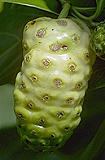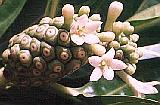|
[Front Page] [Features] [Departments] [Society Home] [Subscribe]

Rotten Cheesefruit?...or Great Morinda??
Greg Calvert
If ever there was a more maligned and misunderstood tree than the cheesefruit, I have yet to come across it. Cheesefruit (Morinda citrifolia) is an attractive shade tree with large glossy leaves and is well suited to tropical coastal areas. It is found in coastal Queensland, Northern Territory and extends through to Papua New Guinea, Vietnam and India. Perhaps its other common names give some hint as to why it is not more popular in horticulture: "Rotten cheesefruit" or "Vomit fruit". There can be no doubt that the odour of the fruit is pretty unpleasant.
The fruit is actually a compound structure which is particularly evident when you see it flowering. Each individual segment of the fruit has its own small white flower. The fruit are a lumpy warty mass, green initially and then turning a translucent green-white when fully ripe.
It is at this stage that the fruit smell particularly strong. The reason for the strong smell is to attract fruit bats to disperse the fruit. Along the wind swept beach fronts in which it grows, a very strong scent is needed to attract the attention of the bats. One critic has described the smell as being reminiscent of a strong Roquefort cheese after soaking in a urinal.
 |
 |
|
Each individual segment of the fruit of Morinda citrifolia, has its own small white flower, (right). When ripe, the fruit, becomes a translucent greenish-white (left).
Select the thumbnail image or plant names for higher resolution images (22k and 33k).Photos: Keith Townsend and Ian Sutton
|
Not surprisingly, the smell generally discourages most people from sampling the perfectly edible fruit. Since the senses of smell and taste are closely linked in the mind, smelling the fruit first actually makes the fruit taste worse. The best thing to do is to just hold your nose and take a big bite! The taste is actually something like a strong blue-veined cheese mixed with hot mustard.
I am continually amazed at the number of people who actually like the fruit and I have had many requests for seeds and plants. The last time I was in Darwin, I saw advertised a salad dressing made by blending cheesefruit and macadamia nuts. It was selling like hot cakes to the tourists!
The fruit is high in vitamin C, but quite average in most other nutrients and minerals. Judging by the number of medicinal uses, I am sure that the fruit actually contains pharmaceutical properties. One whole fruit, eaten raw, is taken for the common cold, influenza, diarrhoea, asthma, coughs and sore throats. Many times I have heard that this brings almost miraculous cure and have tried it out on a few willing scapegoats with nothing but 100% success!
More on Cheese Fruit
Elwyn Hegarty, Plantchem Pty Ltd
Morinda citrifolia grows near tropical seas, including along the North Queensland coast. Various traditional cultures have used the plants in medicine and for dyes etc., but the odorous fruit varies in taste and acceptability as a food. Commercial extracts (liquids and powders) prepared from fresh or fermented fruits are now widely promoted as food supplements in the US and elsewhere.
Many advertisements for Morinda and Noni products have ascribed their therapeutic activity to a compound formed during digestion, and known as xeronine. There has been some confusion about the nature of this compound. It is usually described as an allcaloid, but apparently in the broadest sense, because it is not recorded in the chemical literature. Dr Heinecke of Hawaii, who named and was granted the original patent for xeronine (US4543212 of 24/9/85) has explained his use of the term on the web pages here
There is a comprehensive, independent review of the scientific research and historical factors relevant to the recent commercialisation and medicinal uses of Morinda citrifolia products in:
Dixon AR, McMillen H and Etkin NL (1999). Ferment this: the transformation of Noni, a traditional Polynesian medicine (Morinda citrifolia Rubiaceae). Economic Botany 53(1) pp 5 1-68.
The authors conclude that "although these products do have a long history of use for some medical conditions in Polynesian and Hawaiian cultures, the (recent) celebrity of noni is out of proportion to the facts", and they attribute this at least partly to the great difficulty of proving that any improvement in chronic medical conditions is due to a single medicine or activity. As in other cases where such information is difficult to obtain, current research may provide some valuable answers.
From the SGAP Queensland Region Bulletin, September 2000
|
|
|
In the Tosses Strait, juice from the fruit is mixed with coconut milk or water and given to patients as an effective cure for the painful disease Ciguatera. The fruit may also be taken as a contraceptive (don't kiss me after you've eaten that horrid thing!) or applied externally to sores and wounds.
Green fruit may be smashed up and eaten as a green vegetable. One Papuan woman explained to me that fruit are also used as shampoo and she assured me they make your hair quite soft and shiny. Keep one handy in the shower cubicle next time.
If you dislike the fruit, then young leaves are also edible, either raw or cooked. In India, leaves are also applied externally to wounds and ulcers. In Vietnam, fruit are taken to relieve painful urination by apparently clearing obstructions from the urinary tract and are also taken to promote menstrual flow.
Other obscure uses include the extraction of a yellow dye for dying dilly bags. It is one of the best natural dyes to be found in North Queensland.
In the Northern Territory, it is regarded as a calendar plant. The timing of fruit ripening and dropping from the tree apparently coincides with the end of the cold dry season and the beginning of the new hot and dry season. This doesn't work well in the Townsville area, since I have seen trees fruiting all year round.
Some research has been carried out into the medicinal value of cheesefruit and there is now a commercial drug based on the roots and trunk of the plant, which is used to treat high blood pressure.
A company calling itself "Morinda" has claimed to have discovered a wonder enzyme, called Proxeronase, which reacts in the stomach to form the alkaloid Xeronine.
|
The juice of Morinda citrifolia is marketed as "Tahitian Noni" and is claimed to assist in the treatment of the following disorders:
- reduced immune system (eg. AIDS, etc.) by stimulating T-cell production
- pain-killing effects
- anti-bacterial (including E.coli)
- a chemical in Morinda called Damnacanthal inhibits cancer.

|
|
A long list of testimonials promoting Morinda / Noni include:
- increased energy and well-being e assist in recovery from Ross River Virus
- assists in controlling blood-sugar levels in diabetics
- reduced need to clear throat
- relief from pain in knees
- relief from chronic back pain
- relief from heart palpitations
- clearing skin of blemishes
- relief from painful infected gums
- relief from sinus, flu, head congestion and asthma
- relief from crippling menstrual pain
- functions as anti-inflammatory to relieve painful joints
|
How much of this is psychological and how much is directly attributable to cheesefruit is anyone's guess, but it certainly puts an interesting slant on a very interesting and attractive native bush food.
Make up your own mind!....... but let's drop the name "rotten cheesefruit" and use its other complimentary common name: "great morinda".
Reprinted from "The Native Gardener" newsletter of the SGAP Townsville Branch April 1998 and November 1998 (via the SGAP Queensland Region Bulletin)
Tahitian Noni Juice illustration from the Morinda company.

[Front Page] [Features] [Departments] [Society Home] [Subscribe]
Australian Plants online - March 2001
Association of Societies for Growing Australian Plants
|